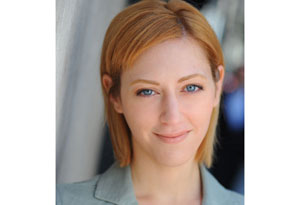Jennifer Wastrom is a pro at setting goals that don't stick. O steps in to help her
finally see one through.

Pictured: Jennifer Wastrom
Jennifer Wastrom is not the kind of person who haphazardly picks a resolution five minutes to midnight on New Year's Eve. But like many people, Wastrom's January goals peter out by June. "I'm very well-intentioned and I always start pretty strong, but I have seriously poor follow-through," she says.
To help her make 2011 the year of living...resolutely, O brought in Kelly McGonigal, PhD, a psychology lecturer at Stanford University, whose courses, such as the Science of Willpower, cover tactics for personal change. She identified the shortcomings of Wastrom's previous goals and introduced her to the finer points of successful resolution-making.
Best-Laid Plans
Considering her overcommitted schedule as PTA president and library volunteer, plus the fact that she has two teenage boys, it's little surprise that Wastrom has never quite managed to run a marathon, master a new yoga level, or "become more cultured"—all rather lofty past resolutions. In 2005 she set out to read a book a month to be an example to her sons. By late spring those books were collecting dust—and she was beating herself up for letting another objective fall by the wayside.
The one resolution that's long topped Wastrom's wish list of self-improvements is to prepare a new dish each week—even though she ranks cooking right up there with scrubbing the toilet. Still, she considers it important to give her family a good meal every evening. "The four of us make an effort to get together for dinner," she says; "the least I can do is have something better than burnt meatloaf for them."
Breaking It Down
McGonigal immediately spotted several worrisome patterns in Wastrom's resolution-making process. First was the choice of goal itself. "Part of Jennifer's motivation was, "This is how I should be, because women are supposed to be good at cooking,'" McGonigal says, adding that that kind of motivation never works. "If you're starting from a place of feeling not good enough, you're just going to give up on the goal when you have setbacks."
Wastrom also became too focused on checking items off a list (like digesting a book per month), instead of remembering the bigger picture (that reading is a gift to yourself). "While the steps need to be small enough to tackle, the why needs to be big," says McGonigal. "A lot of people know to set realistic goals, but they won't follow through if the resolution doesn't really matter to them."
A third land mine was Wastrom's tendency to take failure hard. "It's part of the process," says McGonigal. "One of the key points for any willpower challenge is seeing failure as evidence that you stretched the limits of what is possible for you. Pushing yourself to do something difficult is like exercising a muscle: If you work it to fatigue, you'll hit a wall. But the next time, your limit will be a little bigger."
Onward to 2011
With McGonigal's help, Wastrom chose a pair of resolutions for the coming year. Her first, which McGonigal calls her "hard" resolution (the top-priority objective with a well-defined plan), is to take on cooking again. Her main motivation is to provide her family with meals worthy of the time they spend together, but she's realized it's also important to make the task more enjoyable for her own sake. "Instead of dreading cooking as a big fat pain, I want to make this part of my day something I actually look forward to," she says. Wastrom's secondary, "soft" resolution (a more flexible goal to be explored) is to try a new type of physical exercise. She had been an avid runner before starting a family and was itching to find something equally challenging.
McGonigal then mapped out a plan of attack by identifying some specific steps. In order to improve her cooking skills, Wastrom will try over the course of the year to prepare twice the number of dishes she can currently make, for a total of 12—a saner pace than cramming in a new dish every week. McGonigal also suggested ways make her dinner routine more fun, like having her sons vote on her best and worst dishes, à la Top Chef. As for exploring new types of exercise, Wastrom will take a crack at a number of activities, like spinning and Zumba dance classes, and perhaps try running again. Then she'll pick one to commit to.
Wastrom feels like 2011 is the year she'll be a resolution keeper—long after the noisemakers and Champagne flutes have been put away—and for someone who's always trying to better herself, that means a lot. Her cooking goal feels more achievable, and she sees her new exercise plan as a healthy way of putting herself first. "I'm focusing on the 'me factor,'" she says. "I feel like I'm going to have a great year."
Next: The 4 characteristics of the perfect resolution
To help her make 2011 the year of living...resolutely, O brought in Kelly McGonigal, PhD, a psychology lecturer at Stanford University, whose courses, such as the Science of Willpower, cover tactics for personal change. She identified the shortcomings of Wastrom's previous goals and introduced her to the finer points of successful resolution-making.
Best-Laid Plans
Considering her overcommitted schedule as PTA president and library volunteer, plus the fact that she has two teenage boys, it's little surprise that Wastrom has never quite managed to run a marathon, master a new yoga level, or "become more cultured"—all rather lofty past resolutions. In 2005 she set out to read a book a month to be an example to her sons. By late spring those books were collecting dust—and she was beating herself up for letting another objective fall by the wayside.
The one resolution that's long topped Wastrom's wish list of self-improvements is to prepare a new dish each week—even though she ranks cooking right up there with scrubbing the toilet. Still, she considers it important to give her family a good meal every evening. "The four of us make an effort to get together for dinner," she says; "the least I can do is have something better than burnt meatloaf for them."
Breaking It Down
McGonigal immediately spotted several worrisome patterns in Wastrom's resolution-making process. First was the choice of goal itself. "Part of Jennifer's motivation was, "This is how I should be, because women are supposed to be good at cooking,'" McGonigal says, adding that that kind of motivation never works. "If you're starting from a place of feeling not good enough, you're just going to give up on the goal when you have setbacks."
Wastrom also became too focused on checking items off a list (like digesting a book per month), instead of remembering the bigger picture (that reading is a gift to yourself). "While the steps need to be small enough to tackle, the why needs to be big," says McGonigal. "A lot of people know to set realistic goals, but they won't follow through if the resolution doesn't really matter to them."
A third land mine was Wastrom's tendency to take failure hard. "It's part of the process," says McGonigal. "One of the key points for any willpower challenge is seeing failure as evidence that you stretched the limits of what is possible for you. Pushing yourself to do something difficult is like exercising a muscle: If you work it to fatigue, you'll hit a wall. But the next time, your limit will be a little bigger."
Onward to 2011
With McGonigal's help, Wastrom chose a pair of resolutions for the coming year. Her first, which McGonigal calls her "hard" resolution (the top-priority objective with a well-defined plan), is to take on cooking again. Her main motivation is to provide her family with meals worthy of the time they spend together, but she's realized it's also important to make the task more enjoyable for her own sake. "Instead of dreading cooking as a big fat pain, I want to make this part of my day something I actually look forward to," she says. Wastrom's secondary, "soft" resolution (a more flexible goal to be explored) is to try a new type of physical exercise. She had been an avid runner before starting a family and was itching to find something equally challenging.
McGonigal then mapped out a plan of attack by identifying some specific steps. In order to improve her cooking skills, Wastrom will try over the course of the year to prepare twice the number of dishes she can currently make, for a total of 12—a saner pace than cramming in a new dish every week. McGonigal also suggested ways make her dinner routine more fun, like having her sons vote on her best and worst dishes, à la Top Chef. As for exploring new types of exercise, Wastrom will take a crack at a number of activities, like spinning and Zumba dance classes, and perhaps try running again. Then she'll pick one to commit to.
Wastrom feels like 2011 is the year she'll be a resolution keeper—long after the noisemakers and Champagne flutes have been put away—and for someone who's always trying to better herself, that means a lot. Her cooking goal feels more achievable, and she sees her new exercise plan as a healthy way of putting herself first. "I'm focusing on the 'me factor,'" she says. "I feel like I'm going to have a great year."
Next: The 4 characteristics of the perfect resolution

Pictured: Kelly McGonigal
4 Characteristics of the Perfect Resolution
- Want it for yourself. Don't choose a resolution because someone else wants you to change, or because you think you should do it, McGonigal cautions. In general, the mind-set of self-improvement—that there's something wrong with you that needs to be fixed—is not constructive. New Year's resolutions should be about being good to yourself.
- Be specific but flexible. The steps to achieving your resolution are important because they give you something specific to do and monitor. But leave room to revise these steps if they turn out to be unsustainable or don't lead to the benefits you expected.
- Get support. Sometimes we equate New Year's resolutions with personal willpower, but you don't have to achieve your goals alone. What information or resources do you need? Who can help you? Can you find a group that supports the change you want to make?
- Focus on the why before the what. Before you commit to your resolution, make sure you appreciate the big-picture goal that's driving it. What do you want in your life? What would help you achieve better health and greater happiness?




